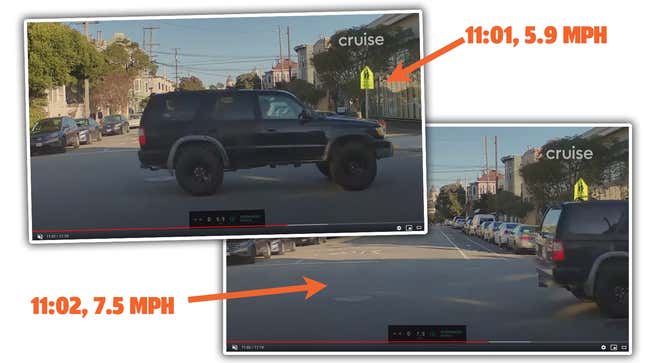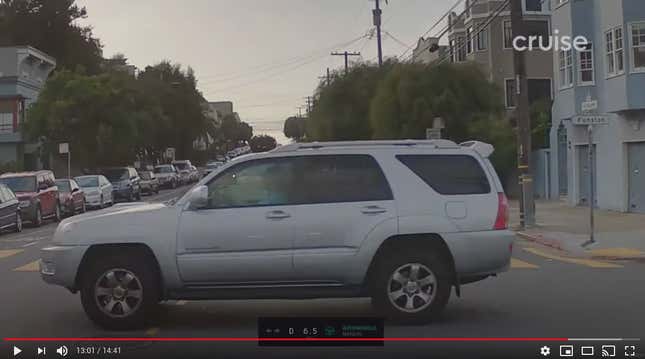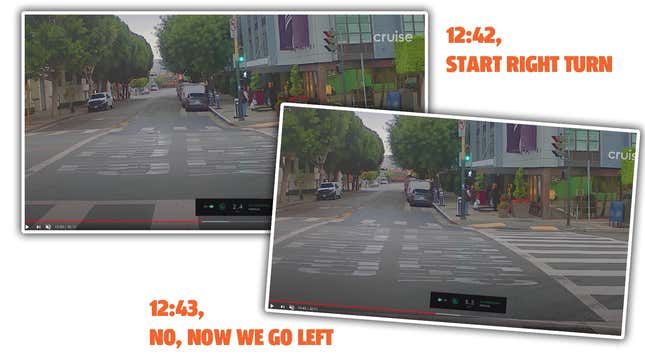Just in case anyone out there forgot, autonomous driving is hard. Incredibly hard. Getting two tons of inert wires and transistors and motors and lenses to somehow navigate a complex, real-world environment is almost comically difficult. The fact that we’re able to make machines that can do any of it at all is amazing.
That also means that if we’re brutally honest, we still have a long way to go before we hit full Level 5 autonomy, and you can clearly see this in some in-car videos shot by Cruise’s fleet of test cars running around San Francisco. I don’t think that was the point these videos were trying to make, though.
Cruise, if you’ll recall, is GM’s autonomous vehicle research and development arm. It announced, to a lot of hyperbole, a design for a driverless people-carrier, and it’s been doing a lot of testing in San Francisco with a fleet of heavily augmented Chevy Bolts.
Cruise occasionally releases video from some of the drives around the city in its test cars. The recordings, posted on YouTube, are usually sped up by a factor of four or so and show unedited in-car camera feeds of drives that would have taken 30 minutes to an hour.
These videos are pretty straightforward, just a record of where the car drove, with a forward-facing video feed that may or may not be the same feed the car is using to navigate — that’s not clear — along with a small informational panel showing what position the gear selector is in, how fast it’s driving, what indicator is on (if any), the position of the steering wheel and if it is in manual or autonomous driving mode.
These videos all seem to keep the car in autonomous mode, and while videos like these have been made public by Cruise, the ones we’re looking at here, while publicly viewable on YouTube, are unlisted. That just means that the videos, while not private, won’t show up in search results.
It’s also worth mentioning that these videos are about 10 months old, according to Cruise, and improvements and changes are happening all the time. So some of these issues may have already been sorted.
Cruise has used videos like this for promotional purposes in the past to demonstrate that its cars can indeed drive for long periods in San Francisco autonomously. The videos we looked at all took place in clear weather, and seem to be shot in early-ish morning hours, around 7 a.m. or so. Based on businesses being open or closed in the background, some drives were possibly on Sundays (though this is just observation).
The videos cover a good bit of San Francisco, but they avoid very high traffic areas like Market Street and do not appear to take drives during rush hours.
Cruise was very recently granted permission to remove the human “safety drivers” from its cars during testing. The drivers are there to take over should anything go wrong. With this crucial safety fail-safe being removed, it may make sense to look at these videos and see the sorts of issues the Cruise cars have and how dangerous they could potentially be.
I should mention that there is plenty in these videos to be impressed by; the cars all do drive throughout the city, without incident, for long periods of time. Many of the behaviors seen are impressive.
But there are issues, no question.
Some of the issues are fairly minor but would still be irritating if you had to ride in one of these; they suggest larger perception and reaction issues that may need tweaking. One of these issues has to do with the difficulty the Cruise car seems to have driving straight in a lane.
A particularly good example of this — though you can find examples at a number of points in all these videos — is in this clip from an hour-long drive around San Francisco, at 11:16 in:
Maybe it’s being too sensitive to the variances of the parked cars, but it’s really ping-ponging in that lane. You can even see how much the steering wheel is moving by looking at the little wheel indicator icon in that info panel at the bottom center.
If it helps, you can click on the gear icon and set the playback speed to 0.25 so it’s closer to real-time speed, letting you see that in more detail.
Another behavior that isn’t so terribly unsafe, but is still not great, has to do with how the car dealt with this charming family of three, taking a bike ride together (9:00):
People on bikes in a cluster can be confusing, I get that. The Cruise car here was sort of shadowing the cycling trio, speeding up and slowing down, which must have made the cyclists feel a bit on edge. There was plenty of time, and clear lanes, for the Cruise car to pass them safely and legally, but it never did.
That’s a tricky situation, though.
What really shouldn’t be tricky is not T-boning a car at an intersection, and yet in another hourlong video, we get near-misses of just that. In fact, we get three in a row, for a near T-bone trifecta!
First, the Cruise car didn’t see a scooter (10:53):
...then, at the next intersection, we watch the Cruise Bolt almost hit a Toyota SUV (11:01):
Just to give a bit more detail, you can see here that the Bolt was accelerating as the SUV was crossing in front of it, hitting almost 6 mph with the car dead ahead, and not stopping accelerating, reaching 7.5 mph as the SUV barely gets past:

From what we can see in the video, the Cruise car either had no idea the SUV was dead ahead of it, or for some reason didn’t care. No rational human who wanted to avoid a wreck would be accelerating as a car crossed right in front of them at an intersection like that.
And, incredibly, here’s our third intersection near-miss, completing the trifecta:
This time, there’s a lot going on at the intersection: the Cruise car is making a left turn, there’s a car getting a jump, cyclists, a truck passes — this is an awful lot of activity, but by no means unusual for a decent-size city street.
Is that why the Cruise car completely misses the black Camry coming at 11:08? Again, we have a situation where the Cruise car is gaining speed right as another car is directly in its path, and it doesn’t seem to notice at all:

These are all pretty bad near-misses. I mean, I have to hand it to Cruise for not editing the videos at all, but maybe no one really looked over them in detail? Or, perhaps they did, and that’s why the videos are unlisted? I really don’t know yet.
We see a similar near-T-boning in the first video I showed you, too, at about 13:00:
Again, we see the same sort of pattern: The Cruise car begins to cross the intersection without seeing a vehicle approaching from the perpendicular street and continues to accelerate even as the crossing vehicle is very obviously right in front of it. Here’s a screenshot of the SUV dead ahead, as the Cruise car hits 6.5 mph and climbing:

This kind of thing is, of course, bad, and it makes me uneasy when I think that soon there won’t be backup human drivers in these things.
Now, it is possible that the Cruise car knows exactly how close it can get to the crossing car and has calculated it will not hit the car. For a human, most would pause accelerating as a car passes right in front, but it’s possible it’s done the math and just knows it’ll be fine, even if that does feel weird to humans.
This behavior does limit the margin of error if the crossing car slows or stops, of course, but it’s possible this is expected behavior. If anyone from Cruise wants to explain the process, we’re happy to listen.
Along with near-misses, we also have some more confusing examples. Like, what’s going on here, at about 12:30?
So, the car was sitting at a light, waiting patiently to make a right turn, indicator blinking, when, after starting to make the turn, the car changes its mind at 12:43 and then decides to turn left, right in the middle of the intersection?

What happened here? Why would it change direction mid-turn? The intersection is empty the whole time, so it’s not reacting to some vehicle in the way. Look how much it’s cranking that wheel to make this strange turn in the intersection, too:

I just don’t have enough information to know what’s going on with all of the situations here, but I can look at these videos and see that there’s some strange and potentially dangerous behaviors happening.
There’s lots of good behavior as well, I want to reiterate, but that’s the thing about autonomous driving: It doesn’t matter if you get 95 percent of it right when that last 5 percent involves driving into another car.
To get to full Level 5 autonomy, I think we need to accept that the path may well be asymptotic — we’ll get closer and closer, but that last little bit may very well take a lot longer than we expect.
That’s why when you hear things like Elon Musk saying Tesla is very close to full Level 5 autonomy, and saying things like
“So, yes, I think there are no fundamental challenges remaining for level five autonomy. There are many small problems. And then there’s the challenge of solving all those small problems and then putting the whole system together, and just keep addressing the long tail of problems.”
Remember, those “many small problems” are things like what we’re seeing in these videos, and these problems, however small in the grand scheme, are absolutely big deals. You can’t be dismissive like that about what it takes to get to Level 5.
We’ve reached out to Cruise for comment on the videos and will update when and if we hear back. Let’s hope they don’t just take the videos down. They’ve been transparent so far, so I hope that continues.